|
The Homo Erectus
Variation of the Caro-Kann Defense, Part III
As promised, I'm continuing with my secret home analysis of the "Homo
Erectus Variation" of the Caro-Kann Defense. I've named it this way in
honor of
Michael Goeller's "Caveman Variation," 1. e4 c6 2. d4
d5 3. e5 Bf6 4. h4. In the Homo Erectus Variation we play the
even more primitive 4. g4!?
I've discussed Black's replies 4. ... Bg6 and 4. ...
Be4 in my last two entries, and so we now come to what is probably the best and
certainly the solidest answer, 4. ... Bd7.
Let me begin with some general discussion. First, I have to admit up front
that my record against 4. ... Bd7 (2 wins, 3 losses) is not nearly as good as
the other two variations (11 wins, 2 draws, no losses!). One reason, I think, is
that I have underestimated the move, and consequently I did not do my homework
against it. It looks as if Black is letting White accomplish exactly what he
wants. The point of 4. g4, after all, is to drive Black's bad bishop back inside
the pawn chain. With 4. ... Bd7, Black is agreeing to be driven back. So White
should be happy, right?
Well, not necessarily. More than anything else, 4. ... Bd7 is a practical
move. Black realizes that the most important thing for him is to create no
weaknesses. The fundamental reason that the other moves, 4. ... Bg6 and 4.
... Be4, fail is that White can weaken Black's kingside, either with e5-e6 or
with Ne2-f4xg6. Thus the weakness that White voluntarily created with 4. g4 is
compensated by the weaknesses that White induces in Black's camp. But in the
line 4. ... Bd7, White does not get any obvious weaknesses to attack. Black has
an inherently more solid pawn formation. So White needs to look somewhere else
for compensation.
I think it's quite revealing that the only grandmaster I have ever played the
Homo Erectus Variation against, GM Alexander Shabalov, chose 4. ... Bd7.
Grandmasters, more than regular players, are sensitive to weaknesses and don't
take them lightly.
However, after 4. ... Bd7 I'm definitely not ready to throw in the towel for
White. There are some potential imbalances in White's favor. If White can force
Black to play ... e6, then Black's bishop on d7 will look really sick. So one
objective for White is to make sure Black plays ... e6. However, Black can still
liberate the bishop (and the rest of his position) by playing ... c5. Therefore
White should also do his best to prevent ... c5, or if he can't prevent it, to
exact some sort of price. Typically the price will be a weakening of the pawn on
d5, so that White can strike back with a timely c2-c4. Or, as in the
Kramnik-Leko game below, the price may be that White wins a bishop for a knight.
Finally, another general consideration to keep in mind is that this variation
is a whole lot like one of the book lines in the Caveman Variation. Compare our
starting position:
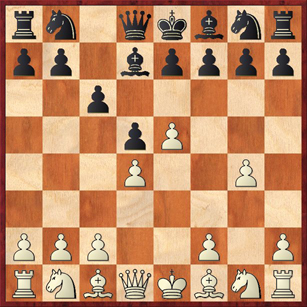
Homo Erectus Variation after 4. ... Bd7
to the position after 1. e4 c6 2. d4 d5 3. e5 Bf5 4. h4
h6 5. g4 Bd7:
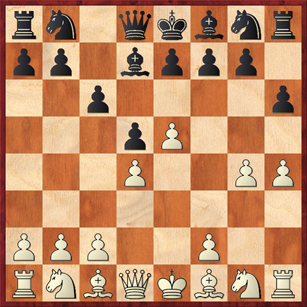
Caveman Variation after 5. ... Bd7
They're almost identical. The only difference is the insertion of h4 and ...
h6 in the second diagram. But in many cases, those two moves will make no
difference at all. Specifically, here are the ways that the difference could
play out in the game.
- In the Caveman Variation, White has an option of playing h4-h5. In the
Homo Erectus Variation, he doesn't.
- In the Homo Erectus Variation, White has an option of defending his
g-pawn with h3. In the Caveman Variation, he doesn't.
- In the Homo Erectus Variation, the squares g5 and h4 remain available
for White's pieces, either a bishop or a knight. This is occasionally
relevant (we'll see an example in the Kramnik-Leko game).
- In the Homo Erectus Variation, White has a hole on h4 that Black could
take advantage of with a later ... Qh4. This could be a problem, especially
if White plays f4 prematurely. But if White develops normally with Nf3, it's
usually not an issue.
Of these differences, number 1 seems to be the most significant at first.
That's because one of the main theoretical lines starting from the second
diagram is 6. h5. So if we needed that move to make this position playable for
White, we'd be in trouble.
But we don't! I will cover four possible options for White, starting from the
first diagram:
(A) 5. Bg2 (okay)
(B) 5. Nc3 (not so good)
(C) 5. c4 (interesting)
(D) 5. Nd2! (perhaps the best)
(A) 5. Bg2 is the move I have played in three of
my tournament games. The thing I like about it is that it keeps alive the option
of answering ... h5 with h3. It also puts pressure on d5, so black can't play 5.
... c5 right away. In two of my games, Mackenzie-Ruiz 1994 and Mackenzie-Border
2004, Black played 5. ... e6. I didn't do
particularly well in either of these games. White can't really stop Black from
playing ... c5. However, if Black does this move then White should strike back
aggressively with c4, because Black's d5 pawn is somewhat weakly defended, and
if he takes on c4 White will get some Catalan-like pressure along the long
diagonal.
Here are a couple of sample lines. (Warning: computer analysis, use at your
own risk): 6. Nf3 c5 7. O-O Nc6 (7. ... Bb5 may be
better) 8. c4!? cd 9. Nxd4 Nxe5?! 10. cd and Black
can't recapture because of a pin on the e-file. Or 8. ...
dc 9. dc Bxc5 10. Nd2 b5 11. Ne4 Be7 12. Be3 and Fritz is confident that
White has compensation for the pawn. Note especially the tangled-up development
of Black's kingside.
My third game in this sub-variation (actually, the first one chronologically)
was my game against GM Alexander Shabalov in 1993. What would a grandmaster do
in this variation? Interestingly, he went straight for the jugular: the weak
pawn on g4. He played 5. ... h5!? 6. h3 Nh6!? (6.
... Qc8 also looks good, but perhaps misplaces Black's queen slightly.)
7. Bxh6 Rxh6 8. g5 Rh8! (If 8. ... Rg6 9. h4 the
rook could get trapped.) 9. Ne2 h4!
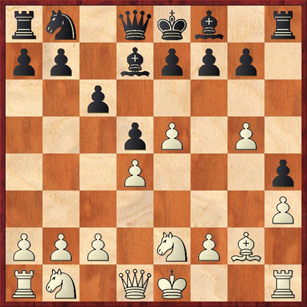
A clever move by GM Shabalov, making my g-pawn somewhat difficult to defend
and also securing f5 for his bishop. (Now I won't be able to play Ng3 with the
idea of trading the knight for the bishop.) For these reasons I think that it's
already impossible for White to hope for an advantage in this position. But
White at least ought to be able to equalize. And the correct way to do
it is, once again, with the thematic move 10. c4!,
putting pressure on Black's center. Instead I played 10. Nf4?! and got crushed.
Bottom line: I think that 5. Bg2 is okay for White, but
doesn't promise a real advantage. My struggles in all three games (one win,
two losses) resulted from my inadequate understanding of the importance
of the move c4 for White, which gives the position a just slightly
Catalan-ish feel (although with the weird moves e5 and g4).
(B) If you've read over my comments on sub-variation (A) carefully, you can
already tell what's wrong with 5. Nc3. White can't
defend the pawn on g4 very well. Also, White has blocked his thematic
counterplay with c4. Nevertheless, I have played this move twice (see my
previous comments about not doing my homework). My results were 1 win and 1
loss. In all the games on chessbase.com, through 2007, White has scored an
appalling +10 -18 =8, or a 39 percent winning percentage. If you believe in
statistics, that should be a pretty convincing argument against playing 5. Nc3.
Here is my most recent game with 5. Nc3, against national master Chris Van
Krogh in 2007:
5. ... Qc8. Black decides that it's worth
putting his queen in a somewhat strange position in order to force White to move
his g4 pawn, thus allowing the QB to re-enter the game at f5.
6. Be2 Na6 7. Be3 b5 Definitely a move I was not
expecting. We have an interesting situation where both sides are a little bit
stymied on the kingside. White can't play Nf3 because it would leave his g-pawn
unprotected. Black can't play ... e6 because it would imprison his bishop, and
with the move 5. ... Qc8 he has announced loud and clear that he doesn't want to
do that. Who will blink first?
8. f4?! An instructive mistake. I debated for a
long time between f4 and h4. After either one of them, Black will play ... h5
and force White either to play g5 or gh. The difference is that after 8. h4 h5
9. g5 White will at least have the square f4 available for his knight.
Here's one way to think of it. If White is going to yield to Black a nice
outpost for his pieces (f5), at least he should get a nice outpost in return
(f4).
8. ... h5 9. gh Nh6 10. Bf3 Bg4 11. h3 Bxf3 12. Qxf3
Nf5 13. Nge2 e6 14. Rg1 ...
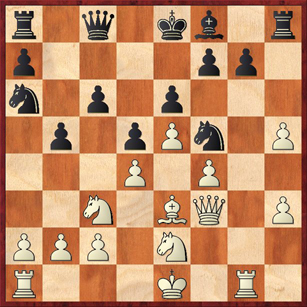
Black should be very happy here. He's got the outpost on f5, and White
doesn't have a corresponding outpost at f4. But now Black makes an instructive
mistake. Under no circumstances should he be tempted to trade his beautiful
knight on f5 for White's do-nothing bishop on e3. Instead, he should play 14.
... b4 15. Na4 c5 16. Nxc5 Nxc5 17. dc Bxc5 18. Bxc5 Qxc5. Black's control of
the dark squares and White's weak pawns on c2, h5, h3, and f4 give Black a
serious advantage.
But Van Krogh chose 14. ... Nxe3? 15. Qxe3 Rxh5=.
Why? In a word, materialism. I think that he was worried about how he was
going to regain the pawn that he had sacrificed.
Van Krogh did end up winning this game, after a very interesting middlegame
that I discussed in my ChessLecture, "Switching Gears Between Strategy and
Tactics."
Bottom Line: Strategic considerations and practical
tournament results all indicate that 5. Nc3 is not recommended.
(C) After I said repeatedly in line (A) that White should reply to Black's
... c5 with c4, and criticized line (B) because White does not have the c4
option, you might be wondering, "So why doesn't White play
5. c4 right away?" That's a good question! In fact, on ChessBase this
seems to be White's most popular move, by a small margin, and it also does
pretty well in practice, with a record of +21 -11 = 12 (a 61% percentage for
White).
Unfortunately I can't speak about 5. c4 from a position of experience,
because I have never played it in a tournament game. I did do some home analysis
of this line in 2006, when I was getting ready to play Jeff Mallett (our local
Caro-Kann player), in the Santa Cruz Cup. After Jeff's unpleasant experiences
with 4. ... Be4, which you saw in my last entry, he had started playing 4. ...
Bd7 in speed games, so I thought I was likely to see it. However, he crossed me
up and avoided 3. ... Bf5 altogether. As a result I never used my home
preparation, and by the time my game with Van Krogh came around I had
forgotten all about the possibility of 5. c4. Seriously, what's the good of home
preparation if you can't remember it?
As it turns out, my home preparation was faulty anyway. After 5. c4 Black has
two options: take on c4 or play ... e6. If 5. ... dc?! 6.
Bxc4 e6 7. Nc3 White is doing pretty well, because 7. ... c5?! is met by
8. d5! with either d6 or de, weakening Black's kingside, to follow. This is a
good example of exacting a price from Black for playing ... c5.
Maybe I should also mention here that 7. ... Qh4? does not work either. White
simply sacrifices the g-pawn with 8. Nf3! Qxg4 9. Rg1. Black's queen gets nearly
trapped on the kingside, White gets rapid development of his pieces while Black
has trouble finishing his development, etc.
So, all in all, the best answer to 5. c4 seems to be 5.
... e6. And so this is a big point in favor of the 5. c4 line. Unlike
lines (A) and (B), where Black was not really forced to lock in his d7 bishop,
in this line it does seem to be basically forced.
The most natural continuation is 6. Nc3 Ne7
(note that 6. ... dc would transpose to the line already given).
Now we come to my erroneous home preparation. I had the idea of following up
with 7. c5?! Basically I'm telling Black, "Sorry,
you had your chance to trade on c4 and you didn't take it, and now I'm going to
put you in a stranglehold." But White isn't well enough developed to pull this
off. After 7. ... b6 the pawns, especially the c-pawn, are overextended. My idea
was to play 8. Be3 with the idea of blockading Black in the center. But after 8.
... bc 9. dc h5 10. g5 (I would probably play 10. f3, but the computer says that
is ghastly, too) Nf5, the only question left is which of White's three overeager
pawns (c5, e5, and g5) is going to go on the chopping black first.
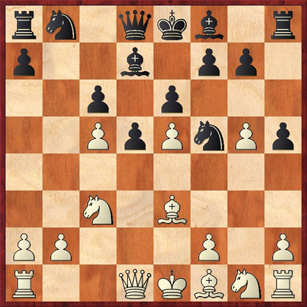
How Not to Play the Opening for White.
Since my home analysis was so flawed, maybe I should be glad that I never
tried this out.
Bottom Line: 5. c4 is an interesting try, but my attempt
to "brute-force" the position with 7. c5 is too ambitious. This means that
White should probably just continue developing with 7. Nf3. Beyond that I
don't have the tournament experience or home analysis to give you any
guidance. (Reader comments are invited!)
(D) That brings us to my top recommendation, 5. Nd2. This move is inspired by
Vladimir Kramnik, who played the identical idea in the decisive 14th game of his
world championship match with Peter Leko in 2004. You can find this game easily
on the Internet, but there's no better place than
Kramnik's own website. This is, in my opinion, one of the deepest and most
beautiful games of the 21st century so far, which was really won by Kramnik's
virtuoso handling of the endgame and not so much by the opening. Nevertheless,
it can't hurt for us to follow the example of one of the greatest games in
recent chess history!
There is little that I can add to the comments on this game by Kramnik
himself. However, there is one important point for me to discuss: How much of
this game is applicable to the Homo Erectus Variation? The actual move order in
the game was via the Caveman Variation, so the moves 4. h4 h6 were played. The
good news: There is a minor difference on move 14 that is actually in White's
favor, and after that there is no difference at all until move 30, by which
point White is already winning and would simply have to choose a different
winning technique.
So -- here are the moves of the imaginary game "Not Kramnik" vs. "Not Leko,"
which was not played in 2004.
1. e4 c6 2. d4 d5 3. e5 ...
"The only move (in the given match situation)," Kramnik writes. By this he
means that he was forced to play for a win. On a draw, Leko would have become
the new world champion. He chose the Advance Variation because it avoids pawn
exchanges and the liquidation of material.
3. ... Bf5 4. g4 Bd7 5. Nd2! ...
On his website, Kramnik is very modest about this move. "A novelty of dubious
quality, the main basis of which was my desire to deviate from theory as soon as
possible."
5. ... c5
I will discuss some alternatives below.
6. dc e6 7. Nb3 Bxc5 8. Nxc5 Qa5+
Black recovers his pawn, but at least White has forced a trade of knight for
bishop.
9. c3 Qxc5 10. Nf3 Ne7 11. Bd3 Nbc6 12. Be3 Qa5 13. Qd2
...
A move that Kramnik played reluctantly, as it allows a trade of queens, but
he did not see any other good way to finish his development and hold on to the
e5 pawn. See his website for analysis.
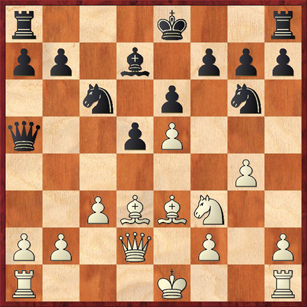
Here we reach the first position where the omission of 4. h4 h6 makes a
difference -- and it's a positive difference for White. Garry Kasparov here
suggested that Black should sacrifice a pawn for activity with 13. ... d4!?
Kramnik amplifies further in the notes on his website: "14. cd Nb4 15. O-O Bb5!"
But in the position above, White can reply 16. Bxb5 Qxb5 17. Ng5! The threat is
to swing the knight around to e4 and d6, and this is very annoying for Black
because he won't be able to post his rook on the c-file. In the actual game,
Kramnik would not have had this resource because Black's pawn was on h6.
13. ... Ng6 14. Bd4 Nxd4
Some people at
www.chessgames.com criticize this move, but I think they're talking
nonsense. It's the most consistent way to play, and I'm sure that Leko felt that
with the queens off the board, the draw and the world championship would
be almost in his grasp.
15. cd Qxd2+ 16. Kxd2 Nf4 17. Rac1! h5 18. Rhg1 Bc6 19.
gh Nxh5 20. b4 a6 21. a4! Kd8?
Too passive. Kramnik recommends 21. ... Ke7 and "Black's position is possibly
defensible; at least, there is no direct win."
22. Ng5 Be8 23. b5 Nf4 24. b6 Nxd3 25. Kxd3 Rc8 26.
Rxc8+ Kxc8 27. Rc1+ Bc6 28. Nxf7 Rxh2
Remember that in the real Kramnik-Leko game, the pawn was on h4, so the move
played was ... Rxh4. At last our "alternate reality" is starting to diverge.
29. Nd6+ Kd8 30. Ke3 ...
And here we have to leave reality entirely. In the real world, Kramnik played
30. Rg1, which would be no good here because of 30. ... Rxf2. But Kramnik also
comments that 30. Ke3 would have been "the most direct way to win." After
30. Ke3 Rh3+ 31. f3
the two versions of reality would coincide: we have exactly the same position
that Kramnik says is won for White.
Okay, so the way that Leko played was a little bit cooperative. Let's look at
two other possibilities besides 5. ... c5. First, Black could play the "Shabalov
move," 5. ... h5. Now (warning: computer analysis
ahead!) Fritz finds the neat idea 6. g5 Bf5 7. Nf3 e6
(maybe here 7. ... h4 should be tried, also à la Shabalov)
8. Nh4!? This offers a pawn sacrifice, but if Black
accepts with 8. ... Qxg5 9. Ndf3 Qe7 10. Nxf5 ef 11. Bd3
g6 12. O-O Nd7 13. Bg5 I think (and the computer thinks) that White has
more than sufficient compensation.
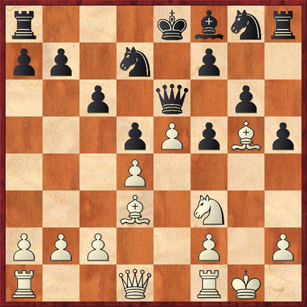
For the time being Black can't castle queenside, his kingside is completely
undeveloped, and his extra pawn is essentially useless. This is definitely worth
a try for White. (Probably Black should play 8. ... Ne7 instead of 8. ... Qxg5.)
Secondly, we should see what happens if Black plays the "Van Krogh move," 5.
... Qc8. I would play 6. Be2, just as in the Van Krogh game. The difference is
that White's knight is now at d2 instead of c3. This creates two possibilities
that didn't exist in my game with Van Krogh: the ideas of c2-c4 or Nb3. The game
is of course playable for both sides, but at least we can see that the move 5.
Nd2 had some point.
Bottom line: Kramnik's idea of 5. Nd2 is certainly
playable here as well. Though modest in appearance, the move is intended to
draw some of the venom from ... c5 by swinging the knight to b3. (Also,
c2-c4 remains an option.) If you have an opponent who tries to follow the
Kramnik-Leko game and play Kasparov's "improvement," 13. ... d4, you have a
nasty surprise for him. Black does not have to play 5. ... c5, but if he
doesn't then 5. Nd2 can be viewed as a slightly improved version of
Variation B.
Wow! This openings stuff is a lot of work! There's one other topic I should
take up, but I don't think I have the energy for it at the moment: namely, what
to do if Black avoids 3. ... Bf5 altogether and instead plays the somewhat
paradoxical 3. ... c5!? Perhaps I will write a post on this topic later, but for
now I'll point you again to
Michael Goeller's page, where he discusses this variation. |
